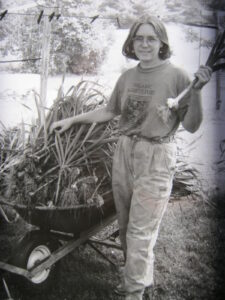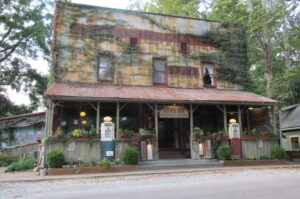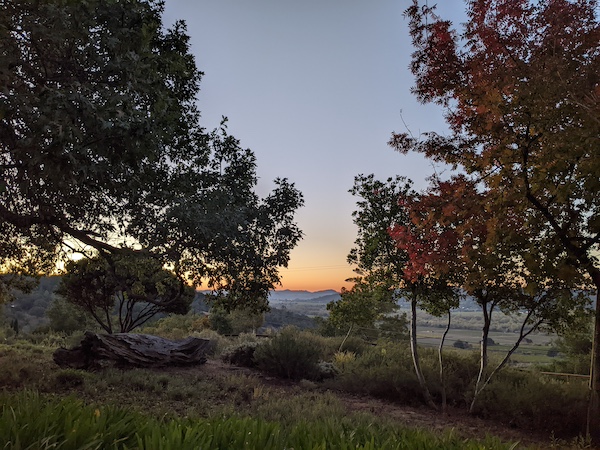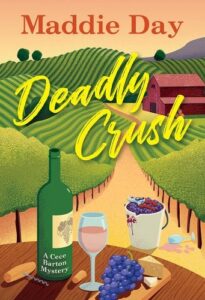I write cozy mysteries, and I’m proud of it. Cozies are all about the characters and their community. The protagonist and the close circle of friends, colleagues, and family who surround her are the main reason readers come back book after book.
Where the community is set is almost as important. When I start a new series, I spend a good chunk of time imagining a place that’s distinctive and unique. I want to create a village my characters love living in. Some writers talk about their setting being a character. While that might be stretching the definition of “character,” I think it could be said of my settings.
So far, I’ve set contemporary cozy series in semi-rural northeastern Massachusetts, in hilly southern Indiana, in a section of Cape Cod, and in a wine-producing valley in northern California. For each of those regions, I created fictional towns loosely based on a real one nearby. I don’t want to worry about which real street is one-way or that a new hair salon or restaurant popped up between two actual businesses. Plus, real stores and restaurants don’t appreciate a fictional murdered body dropping in their aisles!
Still, any good story needs conflict along with great scenery and quirky personalities.
Let me share why my settings are good places for an amateur to try her hand at solving homicides.
Westbury, Massachusetts
My Local Foods Mysteries feature geeky Cam Flaherty, her organic farm, her kindly great-uncle Albert, and the community of regular customers seeking out locally grown produce. Westbury is a classic New England small town within commuting distance of Boston. It struggles with conflicts between old-timers and new more affluent residents, with housing growth versus growing food on the land, and with long-held secrets.
When I was much younger, I owned and ran a small organic farm in a town much like Westbury. While writing these books, I loved being back in the world of farming without having to do all the hard physical work!

South Lick, Indiana
In the Country Store Mysteries, my longest-running series, Robbie Jordan owns and runs the local country store breakfast and lunch restaurant in Brown County, Indiana. Solidly in the middle of the country, fictional South Lick has its share of local residents, but it also sees a good number of visitors. Tourists from all over come to experience Brown County, which is hilly and wooded and has a long history of eccentric artists.
I was inspired to write this series by the memory of two friends who long ago bought a run-down general store in the tiny village of Story, Indiana, and fixed it up into a breakfast restaurant and inn.

In the cozyverse, it’s always good to have strangers come to town so the village doesn’t become known as a place where people are murdered (shades of “Murder She Wrote!”). That’s why, for Nacho Average Murder, book # 7, Robbie traveled back to her hometown of Santa Barbara, California, for her tenth high school reunion. While there, she solves a murder and also discovers the truth about her mother’s sudden death.

But fans missed South Lick and Robbie’s support crew. She doesn’t travel far afield in the books after that.
Westham, Massachusetts
I set my Cozy Capers Book Group Mysteries on Cape Cod in part because it’s iconic. The magical light beloved by artists, the beautiful beaches and bays, the many miles of former rail lines transformed into walking and biking trails, all are magnets for visitors and seasonal residents. Even people who have never visited the Cape in person know about it.

What readers learn through my stories is that real world issues are just as present on the idyllic Cape as elsewhere. Towns struggle with the price of housing and a shortage of places for low-wage workers to live. Residents experience the push-and-pull of trying to preserve historical sites and also allow new development. As with any vacation region, there are conflicts between year-round residents and “summer people.” Sometimes one of those issues becomes entangled with a murder. Mac Almeida and the book group are accumulating a track record of success in detangling the details of homicide cases.
Colinas, California
My newest series, the Cece Barton Mysteries, takes the reader to beautiful Alexander Valley in Sonoma County about ninety minutes north of San Francisco, California. I like to call it Napa’s less well-known but higher-achieving little sister. I created the fictional town of Colinas sited not far from Healdsburg and Geyserville, and I invented Vino y Vida, a wine bar Cece manages where I wish I could hang out and taste vintages.
My San Francisco relatives have a long history in the valley. I’m also originally a Californian, and I’ve been lucky enough to stay in their hilltop vacation home while I write and research the area. I toured a wine production facility with great potential for mayhem and tasted wine at the Alexander Valley Winery (and picked the brain of the server about winery details). I stopped by the Pomo Indian-run casino, and watched the fog rise up in the valley. I smelled the dry live oak leaves and listened to the quail as they ran along the fence. All these details bring life to my depiction of the area.

As with Cape Cod, the Alexander Valley sees a hearty number of visitors year-round and is equally iconic. Colinas is a small town with its own secrets. It features historical homes and buildings first erected in the nineteenth century, including the antique adobes housing the historical museum, the wine bar, a bookstore, and an art gallery. It also has a strip with chain and big box stores.
The town has been threatened by wildfires, which adds stress to living conditions. There are conflicts between developers and historical preservationists, between long-time residents and newcomers, even between the county sheriff – who investigates homicides – and the local police department. In other words, a perfect place to stage a (fictional) murder!
I’m delighted that Deadly Crush, book two in the series, is releasing this month so readers can take an armchair visit to this region I love so much.
***


















